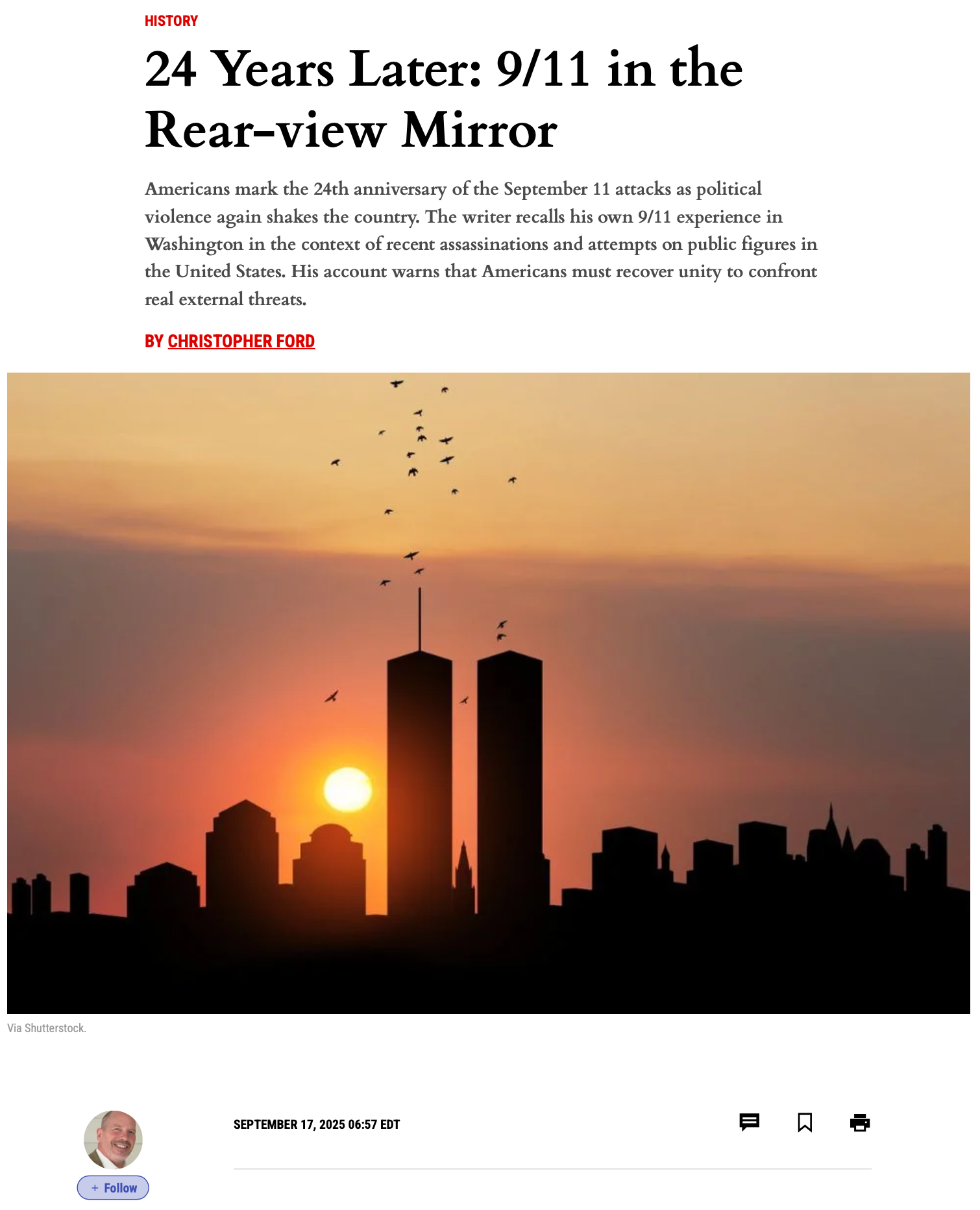Russian Arms Control Compliance and the Challenge of the Next Agreement
Below follow the remarks Assistant Secretary Ford delivered at a Council on Foreign Relations event on June 23, 2020.
Good morning, and thanks to John Bellinger for hosting, as well as to the Council on Foreign Relations for giving me the chance to speak to you.
Let me start by giving you three data points. First, yesterday, U.S. and Russian officials met in Vienna to discuss opportunities for trilateral arms control.
Second, last night, the State Department sent to Congress the unclassified text of the 2020 edition of our Report on Adherence to and Compliance With Arms Control, Nonproliferation, and Disarmament Agreements and Commitments — a.k.a. the “Compliance Report” — which assesses countries’ compliance with their agreements.
Third, last week, my office at the State Department published a paper looking back at the history of the U.S. Compliance Report process and bringing together — for the first time, as far as I am aware — an account of how U.S. officials have assessed Soviet and Russian compliance with arms control agreements throughout the three and a half decades in which the government has been producing public and unclassified compliance analyses.
So what I’d like to do today to try to pull these three elements together, and say a few words about what the history of Moscow’s arms control compliance can teach us about the challenges ahead in trying to negotiate a new arms control framework.
At the most abstract level, a look back across the history of U.S. assessments of Soviet and then Russian arms control compliance offers a window upon shifting geopolitical concerns and priorities, as the pendulum swings from compliance issues related to great power rivalry to (the focus of Reports in the 1980s), to a focus upon nonproliferation and threats from a broader array of states (which emerged as a new theme in the 1990s), and then back again, to some degree, to great power rivalry today.
But a look across the history of U.S. compliance assessments also suggests some lessons about how Moscow approaches arms control, and thus also insight the challenges we face today in trying to build the next arms control agreement.
The early Compliance Reports focus upon bilateral problems of great-power competition. And indeed that era was a strategically fraught and competitive phase of the Cold War. In terms of strategic arms, the 1970s had been a decade of arms control movement, marked by achievements such as East-West détente, for example, as well as negotiation of the Strategic Arms Limitation Treaty and the Anti-Ballistic Missile Treaty.
From the 1970s were also a decade in which Moscow had developed and deployed a new generation of strategic and non-strategic nuclear weaponry, bankrolled and provisioned Cuban expeditionary warfare in support of proxy regimes in locations such as Angola and the Horn of Africa, supported guerrilla movements and terrorist groups against countries friendly to the United States in all corners of the globe, invaded Afghanistan, and crushed dissent in the subject nations of the Warsaw Pact. All these Soviet advances came, moreover, on top of the notable U.S. setbacks in the Vietnam War, with social unrest and political protest at home, the Watergate scandal, and the traumas of an oil crisis and rampant inflation.
By the time of the first U.S. Compliance Report in 1984, U.S. leaders had begun to react to Soviet moves across the board, including with the development and deployment of a range of new nuclear systems and a new generation of increasingly potent conventional weaponry.
It was a highly competitive time, and from an arms control perspective, the Soviets reacted more or less as one might perhaps have expected. Those early U.S. compliance assessments paint a picture of the Soviet Union as a superpower determined to eke out any advantage it could vis-à-vis the United States, and which was not particularly concerned about treaty compliance, except merely that it might be a propaganda setback to get caught. These reports also suggest the degree to which American leaders were alarmed by the growth of Soviet capabilities and worried about the degree to which arms control still represented a viable way of limiting these threats.
This picture begins to change, however, in the later years of the 1980s when — both for internal reasons of its own and because U.S. counter-strategy was beginning to convince Kremlin leaders that the competition wasn’t going so well for Moscow — the Soviet Union began to take a different path. During this period, one can see in U.S. Reports a number of prior compliance problems actually being resolved.
Moreover, as the Cold War waned and then ended, this easing of tensions made possible some important arms control achievements, as leaders of the period sought to take advantage of the cooperative possibilities opened up by the new atmosphere of strengthened trust. Enormous nuclear arms reductions got underway, for instance, first with the INF Treaty’s elimination of an entire class of nuclear-capable delivery systems, and then with the overall nuclear reductions mandated by START I.
A new era of conventional arms control in Europe also began, with instruments such as the CFE Treaty, the Open Skies Treaty, and the Vienna Document, designed both to take advantage of and to institutionalize what everyone hoped would be an enduringly benign and post-competitive era of trust and cooperation. The Chemical Weapons Convention was also negotiated, in an attempt to prohibit an entire category of WMD, as well as the Comprehensive Test Ban Treaty on nuclear weapons.
But the easing of tensions that made all this possible was not to last, for Russia’s ambitions to recover global power for itself were not compatible with that cooperative post-Cold War world. Ever since Vladimir Putin became President on New Year’s Eve in 1999, his government has been dedicated to reversing what he has proclaimed to be the 20th Century’s greatest global catastrophe: the collapse of Soviet power.
This is a fundamentally revisionist strategic agenda, and it has helped drive a dramatic deterioration in the security environment. In its service, Putin’s policy:
Placed into this context, the results in terms of Russia’s present-day arms control compliance have been more or less what one would expect. Just as Compliance Reports from the early 1980s show a Soviet Union seemingly quite willing to disregard arms control obligations where such cheating seemed likely to serve its ambitions vis-à-vis the United States, so Putin’s Russia seems again to be willing to ignore its own arms control agreements in service of the Kremlin’s dreams of power.
As detailed in the Reports, Russia’s record of compliance has been woeful. Russia’s compliance problems under the Open Skies Treaty, for instance, began essentially from the moment of that Treaty’s entry into force, and its record of compliance has been problematic ever since. This pattern of behavior has demonstrated Moscow’s willingness to adopt illegal restrictions whenever it wishes, turning them on and off again as if the law were a light switch — undermining the confidence that the Treaty had hoped to provide.
Notwithstanding a provision in the Treaty specifying that imagery from Open Skies overflights “shall be used exclusively for the attainment of the purposes of the Treaty,” moreover, Russia may now be using imagery gathered on these flights to support
its new doctrine of targeting U.S. and European critical infrastructure with conventionally-armed missiles. It has also used airfield designations and illegal overflight restrictions in an attempt to advance what are, in effect, propaganda statements in support of Putin’s regional aggression, claiming that the Russian-occupied Georgian regions of Abkhazia and South Ossetia are “independent states” rather than part of Georgia, and that Russian-occupied Crimea is part of Russia rather than part of Ukraine. So what was supposed to be a Treaty institutionalizing the mutual confidence and cooperation of the early post-Cold War era has thus been “weaponized” by the Kremlin in support of its own aggressive revisionism.
Indeed, Russia has systematically undermined basically all conventional arms control across Europe. In 2007, it announced what it described as the “suspension” of its obligations under the CFE Treaty. Today, Russia has made clear that it will not resume CFE implementation, and it continues to station military forces on the territories of Georgia, Moldova, and Ukraine without their consent. Every Compliance Report from 2015, furthermore, has described Russia as having engaged in “selective implementation of some provisions” of the Vienna Document.
In the nuclear arena, Russia has complied with the New START agreement of 2010. But it has not adhered to all of its promises in the Presidential Nuclear Initiatives of the early 1990s on non-deployment and elimination of its arsenal of non-strategic nuclear weapons, and apparently no longer feels bound by the PNIs. Russia retains a sizable stockpile of up to 2,000 non-strategic nuclear weapons, and it is likely to build many more in the years ahead.
Additionally, as set forth in the 2020 Compliance Report, “Russia has conducted nuclear weapons-related experiments that have created nuclear yield.” “Russian activities during the 1995-2019 timeframe,” we also assess, “raise concerns about Russia’s compliance with its [Threshold Test Ban Treaty] notification obligation.”
Most dramatically, Russia began the covert development of an illegal, intermediate-range, ground-launched cruise missile probably by the mid-2000s. In 2013, the U.S. began to approach Russia to resolve INF Treaty compliance concerns about this missile, and in 2014 declared Russia to be in violation of the Treaty. Today, however, multiple deployed battalions of these missiles pose a direct threat to all the countries of Europe, as well as to the People’s Republic of China. Meanwhile, Russia violated the CWC with its use of an illegal chemical weapon in 2018 in the United Kingdom.
As we attempt to engage Russia and China in a new trilateral arms control framework, this look back across U.S. compliance reporting makes clear what a formidable challenge we face in building effective new arms control.
First, Moscow seems to take an opportunistically instrumental view of compliance with treaty obligations. It may not cheat all the time — and, as noted, Russia seems to be complying with New START — but neither does it shrink from violating treaties if it thinks doing so advantageous.
Second, Russia’s approach to treaty compliance varies hugely depending upon its objectives in the international arena. During the period when the Kremlin still hewed to an approach of cooperation and reconciliation with the countries of the West, keeping agreements was much more the norm. Whenever Russia has sought to rearrange the international system to its advantage, however, it has regarded compliance with obligations and commitments as essentially no more than optional.
This highlights the challenge ahead in building a new arms control framework. It makes clear that the difficulties of ensuring Moscow’s compliance with its obligations and commitments are at their maximum when the Kremlin approaches geopolitics with a competitively self-aggrandizing eye. Under such circumstances, it tends to disregard them frequently — apparently, whenever it thinks it can.
Hence the paradox, and the problem. Such times of distrust and antagonism are arguably also, however, exactly when arms control is most necessary in order to limit the degree to which distrust spirals into a dangerous arms race. (Where tension has eased and trust has grown, after all, there is less need for arms limitation, because there is less sense of threat. We don’t need arms control to feel comfortable with Britain’s arsenal, for instance.) The challenge is that in dealing with a country with Russia’s unprincipled approach to legality, arms control is least reliable when having it is most urgent.
One could probably say many of the same things about the PRC as I have about Russia, given Beijing’s own revisionist ambitions. Over the last generation, China, too, has directed its strategy single-mindedly to expanding its global power at the expense of the existing international order, and it is today building up both its nuclear and its conventional capabilities at an alarming rate.
I’ve written extensively and speak often about the PRC’s ambitions, so I’ll not belabor them here. In understanding the challenges of the arms control environment, however, one must remember that the second and third most powerful military players on the planet today are both dyed-in-the-wool geopolitical revisionists.
To be sure, China appears less frequently in the annals of U.S. compliance reporting than does Russia. That infrequency, however, isn’t exactly to Beijing’s credit. Instead, it speaks simply to the PRC’s general refusal to engage in good faith arms control negotiations in the first place — so there’s much less to assess compliance with. (Even so, our 2020 Report raises concerns about the PRC in connection with yield-producing nuclear testing and biological weapons, and concludes that Beijing has failed to adhere to its commitments not to assist others in developing nuclear-capable missiles.)
So on the whole, given their competitive ambitions, it is not clear that either Russia or the PRC is likely to take arms control compliance seriously if it feels it has any chance to get away with cheating. That, I fear, is the grim lesson of history.
Nevertheless, none of this means that the United States isn’t still going to try. We continue to believe that effective arms control can limit threats, and that it can provide stability and predictability, and we remain committed to pursuing a trilateral agreement with both Russia and China.
Under current circumstances, only a nuclear weapons agreement that binds Washington, Moscow, and Beijing is likely to be effective in averting a new nuclear arms race. Mindful of our obligations under Article VI of the NPT, we seek negotiations in good faith on such an agreement, and we call upon the rest of the international community to insist upon one. That said, such negotiations won’t be easy, and such a deal won’t work if we don’t give verification and compliance enforcement the attention that Russia’s woeful arms control compliance history makes clear these issues deserve.
Thank you. I look forward to your questions.
-- Christopher Ford







